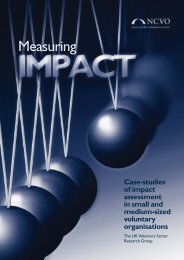A guide to third sector trading - WCVA
A guide to third sector trading - WCVA
A guide to third sector trading - WCVA
You also want an ePaper? Increase the reach of your titles
YUMPU automatically turns print PDFs into web optimized ePapers that Google loves.
It’s an idea, but is it business? A <strong>guide</strong> <strong>to</strong> <strong>third</strong> sec<strong>to</strong>r <strong>trading</strong><br />
1: Getting<br />
started<br />
2: First steps 3: Business<br />
planning<br />
4: Legal and<br />
governance<br />
5: Funding<br />
and<br />
resourcing<br />
6: Financial<br />
controls<br />
7: Managing<br />
growth<br />
8: Management<br />
and<br />
governance<br />
9: Social<br />
enterprise<br />
10: Sources<br />
of support<br />
Making sense of the balance sheet<br />
Start here: The balance sheet is the single most important piece<br />
of financial information that most direc<strong>to</strong>rs will encounter. If you<br />
are not familiar with balance sheets, you need <strong>to</strong> learn what they<br />
contain and how <strong>to</strong> interpret them. This section is intended for you.<br />
You should also refer <strong>to</strong> the model balance sheet for Anywhere<br />
Enterprises Ltd in Table 6.2. With the balance sheet you will get:<br />
• an overview of the organisation’s finances<br />
• a simple way <strong>to</strong> moni<strong>to</strong>r change<br />
• the possibility of tracking different <strong>trading</strong> activities separately<br />
• the reassurance that most aspects of your financial recordkeeping<br />
are in good order<br />
• answers <strong>to</strong> questions which newcomers may not have thought<br />
of asking.<br />
Moni<strong>to</strong>ring more than one <strong>trading</strong> activity: If your organisation<br />
has more than one <strong>trading</strong> activity your balance sheet reports may<br />
need <strong>to</strong> be adapted <strong>to</strong> show details for each of them separately<br />
in addition <strong>to</strong> the composite picture for the whole organisation.<br />
The combined information may be easier <strong>to</strong> compile and easier<br />
for direc<strong>to</strong>rs <strong>to</strong> understand. But separate itemised figures for each<br />
business should be prepared regularly by finance officers, even if<br />
they are not always circulated <strong>to</strong> the full board.<br />
Knowing you’re in safe hands: The requirement that all this<br />
information is presented <strong>to</strong> the direc<strong>to</strong>rs in writing at a set time<br />
every month (<strong>to</strong>gether with a system for the treasurer or finance<br />
committee <strong>to</strong> periodically check the accuracy of the information<br />
which is reported) provides the best evidence you can get of<br />
quality financial controls.<br />
• Simply receiving a full report implies that the accounts assistant,<br />
treasurer, manager, or whoever does the graft, has properly<br />
recorded all the month’s financial transactions, has banked the<br />
cheques and cash, paid bills, and extracted relevant information.<br />
• Depending on your organisation’s needs, the balance sheet may<br />
also include the outcomes of other key checks and procedures,<br />
including:<br />
− ensuring there are no hidden outstanding debts or spending<br />
shocks which have not yet reached the bank account<br />
− identifying who owes the business money, how much, and<br />
how old the debts are<br />
− bringing the PAYE payments up <strong>to</strong> date<br />
− maintain an ongoing VAT record<br />
− balancing the petty cash<br />
− carrying out a monthly s<strong>to</strong>ck check<br />
156












